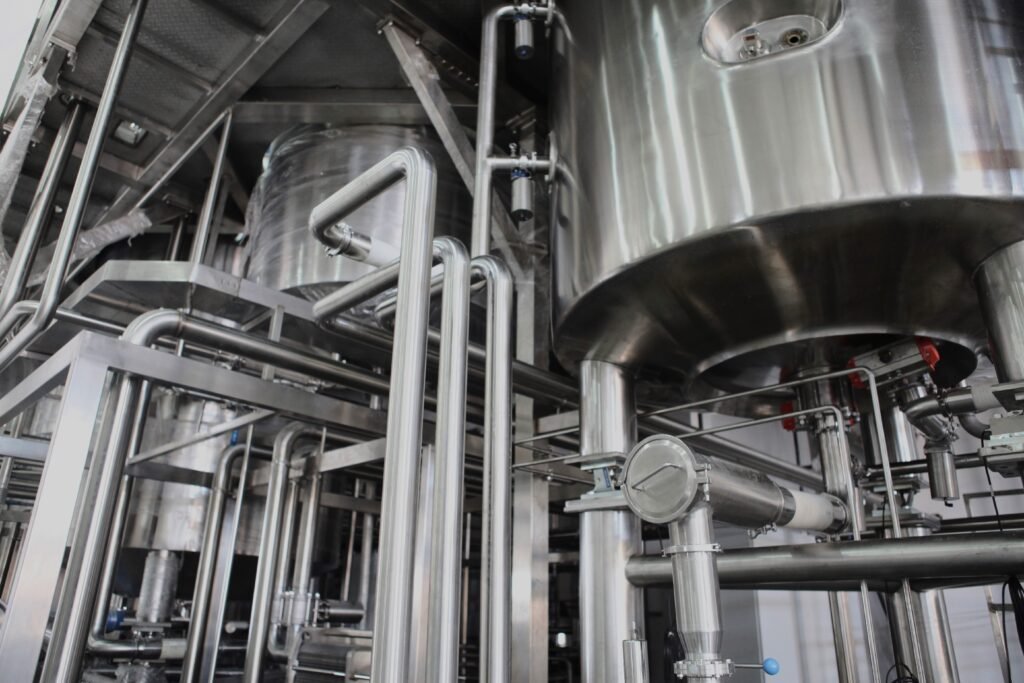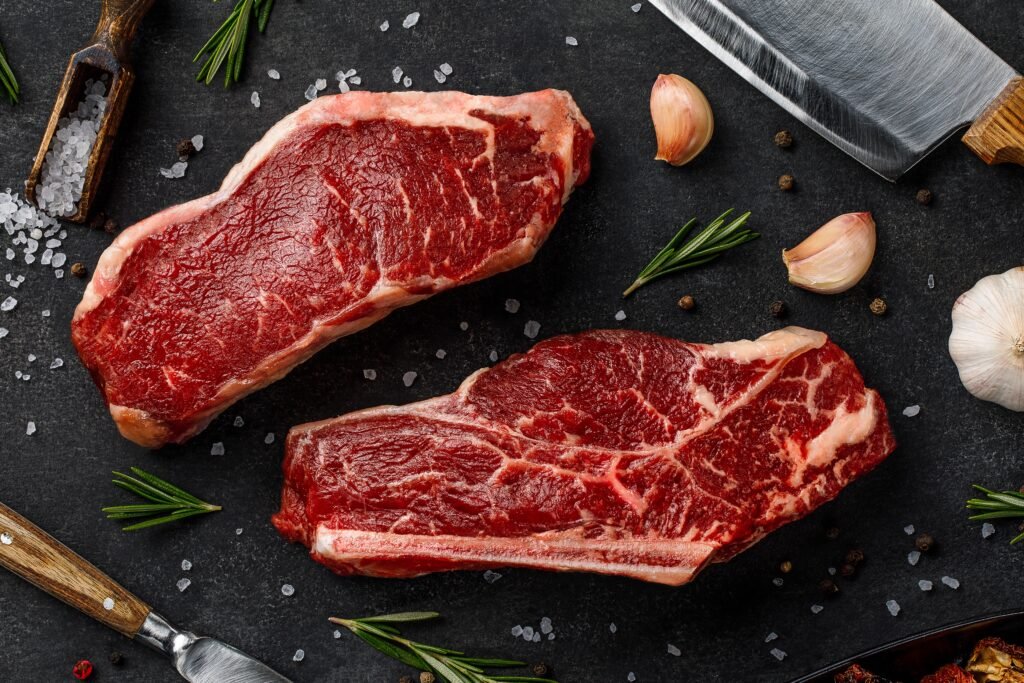Cellular Agriculture
A Rapidly Evolving Industry
Tackling Challenges in Scaling
Cellular agriculture involves the cultivation of animal cells within bioreactors to recreate products that are traditionally derived from animals, such as meat, milk, collagen or leather.
This process significantly reduces the use of land and water, cuts down greenhouse gas emissions, and minimizes animal slaughter, providing a sustainable and complementary alternative to conventional animal farming.
However, before these products can reach our markets, substantial efforts are needed to enable high-scale production and achieve price parity with current offerings.

Cultivated Meat,
The Future of Food
Unlike plant-based alternatives, cultivated meat replicates the muscle, fat, and connective tissues that give meat its appealing taste. It yields a variety of products, including beef, lamb, chicken, fish, and crustaceans.
Its production leverages cutting-edge biotechnologies, novel biomaterials, as well as the latest innovation in food science. The dynamism of the ecosystem, coupled with the complexity of the technologies involved, makes it challenging to identify the most promising approaches.

Open Access Insights
Cellular Agriculture
Landscape and Technologies
To stay at the forefront of the latest developments, we clarify the technology landscape within this industry, making it easy to identify the advantages and drawbacks of selected solutions, which in turn helps you assess a company’s potential for success. Additionally, gain insights into the industry’s high degree of innovation, which presents numerous opportunities for current and new players.
Cell Line Development
Various primary cell types can be utilized in the cultivation of meat, each presenting its own set of pros and cons. Different methods and manipulations can be employed to attain a pure cell population and/or improve their properties to meet the requirements of high-scale production.
Numerous companies are developing advanced technologies crucial for creating animal cell lines ideally suited for the cellular agriculture industry.
Genetic Editing Tools: Precisely tailoring cell line characteristics through the introduction of novel editing technologies that offer higher control and specificity.
Next-Gen DNA Sequencing: Improving bioinformatics and genetic engineering capabilities by making DNA sequencing more accessible and affordable.
Artificial Intelligence: Efficiently processing vast amounts of omics data with AI, enhancing the efficiency of cell line engineering methods.
- Adult stem cells
- Mesenchymal stem cells (MSC)
- Preadipocytes
- Satellite cells ↵
- Pluripotent stem cells ↵
- Embryonic stem cells
- iPSC (through reprogramming)
- Other Cell Types
- Fibroblasts
- Immortalization
- Spontaneous
- Induced (transcription factors)
- Genetic modification (GM)
- CRISPR
- Lenitiviral vectors
- Reprogamming methods
- Transcription factors
- mRNA delivery
- FACS
- High doubling capacity
- i.e. ability of cells to undergo numerous divisions before reaching senescence.
- Necessary to produce quantities compatible with the food industry.
- Growth in suspension
- Short doubling times
- i.e. High growth rate.
- Low nutrient requirements
- Allow media cost reduction.
- Robust differentiation capacity
- Ability of cells to retain their differentiation capacity even after numerous cell division.
- Genomic stability
- Required for regulatory approval of most countries.
Towards Cost-Effective Media Formulations
Cells grow in cocktails of ingredients known as media, which stands as the primary cost-driving factor in cultivated meat production. The composition of the media is thus optimized to foster the expansion or differentiation of target cells while simultaneously minimizing costs.
Ingredients can be sourced from various origins: plant-derived, animal meat by-products, or synthesized as recombinant proteins. Advances in the creation of these recombinant proteins is one of the key to reduce media-related costs.
Media development has resulted in highly effective serum-free formulations for animal cell growth and differentiation. However, these formulations are still 10-100 times too costly. To address this, numerous players are diligently working on more cost-effective solutions:
- Recombinant Proteins: Making functional proteins more affordable by advancing these manufacturing technologies ( Ingredient Manufacturing).
- Media Recycling Innovations: Developing new techniques in media recycling to enhance efficiency and reduce waste.
- Peptones Substitution: Replacing high purity amino acids with peptones as a more economical option.
- Basal media
- Glucose
- Amino acids
- Mineral
- Vitamins
- Inorganic salts
- Supplements
- Free-fatty acids and glycerides
- Platelet lysate
- Albumin
- Insulin
- bFGF-2
- Plant hydrolysates / Peptones
The development of satisfying media formulations requires testing hundreds of compounds and tens of thousands of combinations with varying concentrations. The development approach and the equipment used can significantly expedite the process to reach something closer to the final version, greatly impacting a company’s success. Altering the media formulation at a later stage may affect the overall functionality of the entire production line.
- Media development techniques
- High-throughput screening
- Design of Experiments (DoE)
- Metabolite analyzer
- HPLC
Advancements in the Proliferation Process
Cells are cultivated within bioreactors, specialized vessels where cell division leads to an exponential increase in cell biomass. Optimal conditions are crucial to maximize cell growth and achieve maximum cell density. Scaling up the bioprocess to industrial production volumes remains one of the main challenges in bringing cultivated meat to the market.
It’s imperative that we step away from traditional pharmaceutical industry standards and thoroughly re-envision bioreactor systems for cellular agriculture. This shift is crucial to achieve the necessary scale and cost-efficiency. Key innovation opportunities include:
- Artificial Intelligence: Employing AI to optimize bioprocesses and bioreactor designs.
- Maintenance Efficiency: Reducing the frequency and complexity of maintenance between batches.
- Material Science: Developing alternatives to traditional steel in bioreactor construction.
- Microcarrier (MC) suspension ↵ for adherent cell lines
- Edible MCs can circumvent the necessity for an extensive filtration process as they can be partially or fully present in the final product.
- Dissolvable MCs can facilitate the cell detachment process from MCs, which is known to be challenging and often results in significant cell loss.
- Self-detachment MCs for continuous cell harvesting.
- Cell aggregate suspension
- More information coming soon !
- Stirred tank: most commonly used setup with proven scalability.
- Wave-bag: widely used in bioprocessing.
- Packed bed
- Hollow fiber reactor: very high cell density can achieved, but scalability is still limited.
Comparative table coming soon !
…..
- Single-use systems: offer a high level of safety by reducing the risk of contamination, yet they contribute to increased plastic waste.
- Steel vessels: are more durable, but their use requires cleaning and sterilization cycles that consume energy and water, leading to the production of hazardous waste. Additionally, the global supply of steel might become a potential limitation in the future.
- Bioprocess efficiency
- Cell concentration: preferably over 10 mio / ml
- “Total media used” – “biomass produced” ratio
- Growth rate: ideally cells double in number every day.
- Retention of cell differentiation capacity
- Cell loss across cell harvesting process steps:
- Operation requirements
- CapEx
- Bioprocess scalability
- Equipment footprint (occupied space)
Enabling Tissue Maturation at High Scale
When striving to produce meat that closely resembles animal-derived meat, cells must replicate the specific tissues found in meat, such as muscle and fat. To achieve this, after the cell biomass reaches a significant volume at the end of the proliferation process, cells undergo a maturation process, aka differentiation, to form the target tissues.
This step often necessitates a distinct setup compared to cell expansion, involving a different bioreactor design, unique media formulation, and scaffolding biomaterials.
The industry faces challenges due to the absence of commercially available tissue reactors and limited accessible information on potential solutions. This situation opens opportunities for new, innovative solutions. Key challenges to address include:
- Scaffold Integration: One of the primary challenges lies in integrating scaffolds within reactors in a way that is automated, sterile, and straightforward.
- Tissue Density and Nutrient Diffusion: Another significant challenge is achieving a high density of tissue within the reactor while ensuring proper nutrient diffusion throughout the entire volume.
- Efficiency in Cell Seeding: Additionally, there is a need for advancements in improving the efficiency of the cell seeding process.
Tissue engineering scaffolds provide a 3D environment necessary for cells to differentiate and form targeted tissues. The scaffolding biomaterials used in cultivated meat mostly consist of biopolymers, including polysaccharides and proteins derived from various sources.
- Seaweed-based: alginate, agar, agarose, carrageenan.
- Animal-based & recombinant proteins: collagen, gelatin, fibronectin, fibrinogen/fibrin, casein, chitosan.
- Plant-based: cellulose and derivatives, pectin, chitosan, proteins from pea, rice, soy, etc.
- Cell-laden hydrogels
- Wet-spinning
- Bioprinting
- Extrusion or bead formation
- Casting
- Porous scaffolds
- Freeze-frying
- Electrospinning
- 3D Printing
- Decellularized plant leaves
- Microcarriers (MCs)
- For example, when MCs used during the proliferation process are used in the maturation process as well.
- Scaffold-free
Comparative table coming soon !
Product Enhancement
Innovations in food science and technology are enhancing the sensory properties of cultivated cells and tissues, making them increasingly similar to animal meat. Additional attributes, such as a healthier nutritional profile and an extended shelf life, are also gaining attention in an effort to make cultivated meat more appealing to consumers.
Producing mature muscle and fat tissues of high quality at scale, while achieving price parity with traditional meat is expected take an additional decade. In the meantime, efforts are focused on compensating for current shortcomings. The industry is actively developing solutions to enhance the sensory appeal of cultivated meat, including:
- Texture & Flavor Enhancement: Implementing solutions to making these properties more akin to traditional meat.
- Red-Meat Like Pigments: Developing and incorporating pigments to mimic the appearance of red meat, enhancing its visual appeal.
- Nutrition solutions: Working on creating products with healthier nutritional profiles, further adding value to cultivated meat.
- Texture
- Taste
- Appearance
- Odor
More information coming soon !
- Shelf life
- Storage
- Packaging
More information coming soon !
Building New Supply Chains for Cellular Agriculture
Creating a viable and sustainable food ecosystem necessitates approaching the entire value chain. This involves the smart integration of various sustainable practices and the active engagement of key stakeholders. It includes farmers and businesses seeking ways to diversify their operations and prepare for impending shifts caused by climate change and the evolving dynamics of the food ecosystem.
Farming
Animal farming and agriculture play an integral role in cellular agriculture by providing the source cells of interest and the raw materials necessary for the production of media ingredients, scaffolding biomaterials, and other ingredients added to the final product.
Coming soon !
Feedstock
Ingredients for media, cells, scaffolding biomaterials, and food products are extracted and manufactured from a variety of feedstocks. Identifying sustainable and cost-effective sources is crucial to achieving price parity between cultivated meat and traditional animal meat, while also ensuring environmental benefits.
- Land Crops
- Corn: Glucose.
- Soybean, chick pea, rice, wheat : Plant proteins, hydrolysates and extracts to produce media ingredients, texturizers, scaffolding biomaterials.
- Marine Crops
- Algae: Fatty acids, proteins.
- Seaweed (subcategory of algae): Alginate, agar, carrageenan.
- Animal tissues for cell harvesting
- Muscle: Satellite cells.
- Fat: Pre-adipocytes, MSCs.
- Skin: Fibroblasts.
- Animal by-products
- Blood: Fibrinogen, platelet lysate
- Skin and bones: Collagen, gelatin
Ingredient Manufacturing
Ingredients are extracted and manufactured from feedstock to match cellular agriculture requirements
- Chemical Manufacturers
- Salts, minerals, fatty acids, vitamins, glucose
- Biotechnology Companies
- Growth factors, amino acids, vitamins
- High purity, high cost
- Food Ingredient Suppliers
- Plant extracts, peptones, minerals, glucose
- Low purity, cost-effective
- Precision fermentation
- Molecular farming
- Microorganism-free protein manufacturing
Note: Open Access Insights pages are regularly updated and expanded to provide the most current information available. For further insights into these areas, check our services and reach out to us.
We welcome comments and suggestions to further enhance the user experience on the page.
